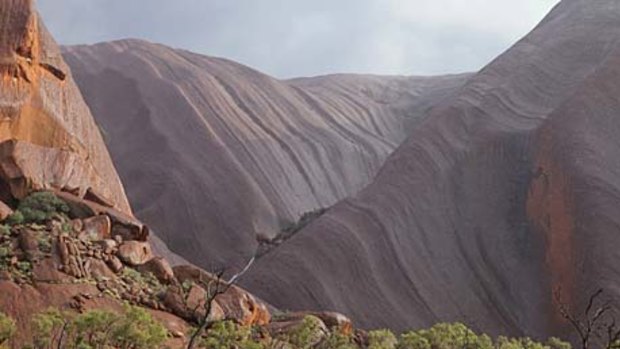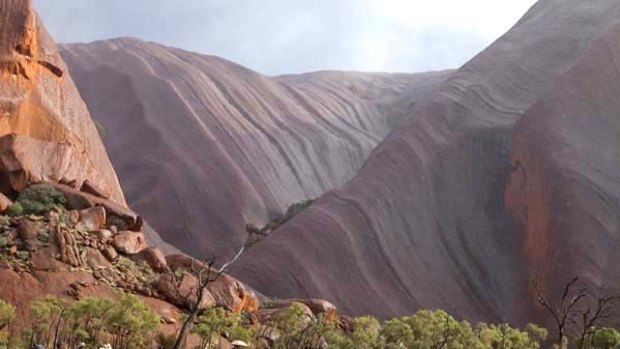
Uluru rain
Helen Greenwood explores Australia's best-known landmark with its traditional owners.
We aren't prepared for a carpet of multi-hued green scattered across the glowing red earth around Uluru. The wettest September on record has made the desert bloom and we're among the lucky ones to see a profusion of wildflowers this month, some of which the rangers at Uluru-Kata Tjuta National Park say they have never seen.
Our luck holds as we head out to see the monolith at sunrise with Anangu Tours. The air is fresh, the sky cloudy and our brains fuzzy. We're cheered by an early-morning cuppa at the viewing car park, part of a $21 million area opened a year ago, and the prospect of meeting our Aboriginal guide after we've watched the changing of the colours on the rock.

Changing palette ... a rainy morning at Uluru.Credit: Steve Pearce
This award-winning tour company is owned and run by the traditional owners of Uluru and the profits are fed back into the shareholder communities. Anangu means "we people" or "we the people". Our driver and guide, Sherry Bell, tells us on the pre-dawn ride to the rock that the word has come to mean "we the black people". She takes us from the sunrise viewing to meet our Pitjantjatjara-speaking guide, Wayne Curtis. He lives in the Mutitjulu community at the foot of Uluru in the old Ayers Rock Resort. About 150 or so Anangu have lived here since their country was handed back to them exactly 25 years ago. The event will be celebrated on Tuesday at Uluru's first cultural festival.
Uluru and nearby Kata Tjuta have profound cultural and spiritual significance for the Anangu. It is thought that Aboriginal people have inhabited the red centre of Australia for 24,000 years and the Anangu willingly share those creation stories that can be heard by those who are uninitiated.
After breakfast at the park's cultural centre, we follow Curtis and his interpreter-guide on the Liru Walk. We pad over flat, packed sandy earth through tall scrubby mulga trees to a shelter where Curtis shows us men's and women's tools, explains their use and demonstrates how to light a fire with dung and make kiti, the sticky resin used to bind spear heads to shafts. We finish with the tragic story of Lungkata, the blue tongue lizard man, who still lies at the base of Uluru.
In the afternoon, we join a dot painting workshop, another session run by Anangu Tours, with Gloria Moneymoon. A painting is your own story, she explains, and you can tell it any way you wish.
A group of adults and children spend 45 minutes dabbing wobbly, misshapen dots from small bottles and paint-dipped skewers, learning the hard way that it takes great dexterity and precision to tell a dot-painted tale. Moneymoon, on the other hand, unfalteringly produces a small, sublime canvas about the Seven Sisters.
A tour to Kata Tjuta with another, new company, SEIT Outback Australia, offers a different, more geological perspective. Our walk into Walpa Gorge is a windy one, with low clouds hovering around the monumental boulders of conglomerate rock. The cloud and rain continue through the day. We front up to our third tour with Anangu, the Kuniya Sunset Tour, and drive straight into a storm so powerful we can't see Uluru until we're a few hundred metres away.
The charming Bell, our guide, makes an executive decision to abort the official tour and refund our money, then offers to drive us around Uluru so we can see the waterfalls cascading down the face of the sandstone rock. Dozens of streams are plummeting to the ground, some dropping into a series of water pools like terraces. An hour later, the storm clears and in a last act of largesse, Bell takes us to see the tranquil Mutitjulu waterhole. Frogs that sound like clapping sticks serenade us as the afternoon sun glints on the water.
Anangu Tours runs a range of tours including sunrise at the rock ($139 adult, $93 child) and a dot-painting workshop ($87 adult, $61 child); see ananguwaai.com.au. SEIT Outback Australia runs private and small-group tours, including a sunrise five-hour tour of Kata Tjuta ($120 adult, $95 child); see www.seitoutbackaustralia.com.au.
SEVEN WAYS TO SEE THE ROCK
By foot
The original and the best way to see the monolith, in my view, is by walking around its base (and not climbing it, which the traditional owners ask visitors not to do). It's an easy 9.4 kilometres and full of wonder; suddenly it's not just a rock but a complex landform of fissures and waterfalls, Aboriginal paintings and caves, surrounded by a surprising diversity of distinctive flora and fauna. There are two shorter walks: Mala Walk (two kilometres) and Mutitjulu Walk, to a permanent waterhole (one kilometre). And after you've paid the three-day $25 park entrance fee, this is the cheapest way to see the rock.
By camel
By the mid-19th century there were about 20,000 camels working across three-quarters of the continent; today they're wild and feral, or saddled up for tourists. Uluru Camel Tours, owned by Anangu Tours, has a 45-minute camel express ride ($65 a person, under-fives not permitted) and hour-long rides to watch the sunrise and sunset ($99). See ulurucameltours.ananguwaai.com.au.
By plane
Prices have tumbled since Virgin Blue began direct flights from Sydney in August. It costs about $189 for the non-stop flight (3hr 30min); Melbourne passengers pay $249 and connect in Sydney. Qantas also flies non-stop from Sydney for about $229; Melbourne passengers pay about $288 and connect in Sydney. Fares are one-way including tax.
By helicopter
The four-seater Robinson R44 looks like an oversized dragonfly and is just as nimble; it offers peerless views of the rock and the mysterious rock domes of Kata Tjuta, 40 kilometres to the west. I'm fascinated by the circular patterns created by spinifex, like grey-green stubble on a red face. Ayers Rock Helicopters runs flights around Uluru and beyond, from 15 minutes ($125 a person) to a 90-minute flight around Uluru, Kata Tjuta and Mount Conner ($690). See www.helicoptergroup.com.
By night
The Sounds of Silence open-air dinner is not about the food, though the buffet is well done. It's about enjoying a glass of bubbles while watching the sun set over Uluru and Kata Tjuta and dining with white napery against red earth under an extraordinary canopy of stars. The evening costs $159 for adults and $82 for children aged 10-12 (under-10s not recommended). See www.ayersrockresort.com.au.
By bus
AAT Kings has a range of flexible touring passes of the area, ranging from a 24-hour explorer pass ($220 a person) to a three-day rock and canyon pass ($408). See www.ayersrockresort.com.au/rock-pass/.
By motorbike
Feel the wind on your helmet astride a late-model Harley-Davidson Heritage Softail. Uluru Motorcycle Tours runs guided tours, from a 30-kilometre Pat's Special ($90 a person) to a 155-kilometre Rock 'n' Olgas ($295) and self-drive tours, too. See www.ulurucycles.com.
Staying there
Voyages Ayers Rock Resort, which was bought last week by the Indigenous Land Corporation and the local community, has a Rock Summer special for two nights' accommodation from $298 a person; extra nights for $49. Two nights at the resort's premium hotel, Sails in the Desert, cost from $432 a person. See www.ayersrockresort.com.au/summer.
- Helen Anderson
Sign up for the Traveller newsletter
The latest travel news, tips and inspiration delivered to your inbox. Sign up now.